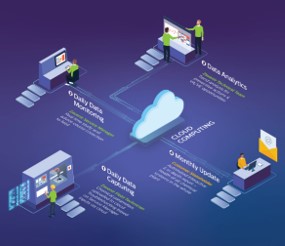Chemistry 4.0 in parts cleaning

Did You Know
Making your Chemicals speak
digitally!!
The need for sustainable performance at economical costs drives the degree of automation in industrial component cleaning. It involves process innovations that combine processes engineering, chemistry, and information technology. Process engineering includes monitoring and controlling the process quality with system components adapted with sensors and actuators. Chemistry 4.0 plays a key role by complementing process engineering with the desired cleanliness levels, cost benefits, and productivity enhancements. The IT part makes the system capable of communication. At the base level, this may be just reporting and recording of control & output parameters. A digital model for process control and cyber-physical systems to minimize human intervention makes it more advanced.
Automated handling of parts has been around for quite some time in the automotive industry. However, cleaning of parts is mostly a batch process with much manual handling. Regardless of whether the parts handling is manually or automatically, the process is usually automatic with standard or part-specific programs stored in the system control. Input systems such as barcode scanners, RFID chips, transponders, or an integrated camera system are available for selecting the cleaning program.
Chemistry 4.0 can measures
key performance indicators such as
Overall Equipment Effectiveness (OEE)
Base for incorporating
not-so-distant
artificial intelligence (AI) systems!
The permanent recording, control, and documentation of various system parameters such as operating hours, power consumption, pressures, and temperatures also contribute to quality improvement or assurance and cost savings. The latter can not only be monitored continuously but can also be adjusted automatically if necessary. The system monitors bath conditions like cleaner chemical concentration, contamination with particles and oils in real-time. This tracking enables the cleaner dosage to be automatically adjusted and intimates a required bath change or filter failure. In the absence of such a system, bath changes that are either too early increase costs or too late, leading to insufficient cleaning quality.
Cloud applications assist in controlling and monitoring the systems & production planning. The data collected in the system control is evaluated and intelligently linked to automatic programs for operations. It predicts system components’ service life and computes the following maintenance schedule based on the number of batches or operating hours that have passed. Also, it measures key performance indicators such as Overall Equipment Effectiveness (OEE).
System control and the operational sensors create possibilities to read out the data and pass it on to a network. It can capture cleaning process data and external factors like ambient temperature & relative humidity. That would be a holistic IoT network in which everything communicates with each other. With this live data, the system can measure the cleaner concentration, the cleanliness of the parts, or the bath contamination, and as a result, take the proper countermeasure.
In combination with Augmented Reality (AR), cloud applications help in fast and location-independent support for maintenance and repair work. The operator can share the system virtually with an expert to access the visual data anywhere in real-time. The expert can easily transmit the troubleshooting or maintenance instructions back to the operator. These developments in the automation and digitization of part cleaning processes are the initial stages for incorporating not-so-distant artificial intelligence (AI) into cleaning technologies.




